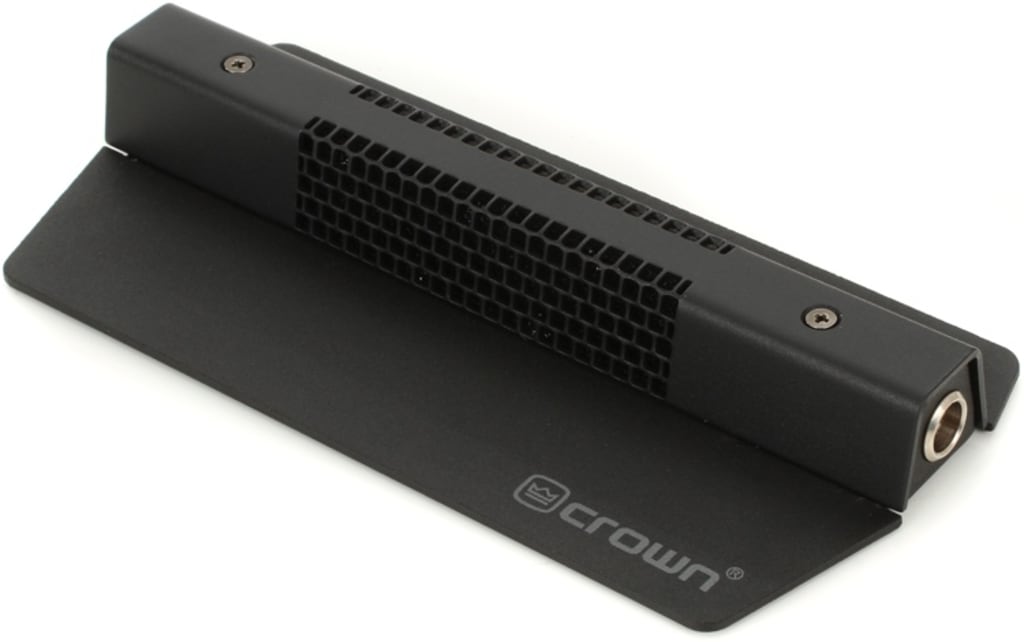PCC160 Boundary Mic
The industry standard floor mic.

1985 was a very interesting year in the microphone market. January of that year Crown International introduced a very oddly shaped and interesting mic called the PCC160. Following the huge success of the PZM’s a few years before, this mic would soon reinvent how stages and theaters all over the country and around the world would mic their productions.
Unlike the conventional mics of the day, the PCC is long and has a flat base. This allows you to place it on a tabletop, desktop, podium and stage floors. Aiming it at the desired sound source from a distance. This was a whole new thing compared to putting your average Shure or Ev handheld on a stand and having it either standing on the stage or directly in front a singer or speaker.
This was what Crown International used to be about…solving problems in the audio world but exceeding in engineering and design and setting the standard for the rest of the market to follow. This mic is no different in that respect; it soon became and still is the industries most #1 used floor stage mic in the world!
*The Details*
The Crown PCC-160 (Phase Coherent Cardioid) is a surface-mounted super-cardioid microphone, intended for professional applications on stage floors, lecterns, conference tables, and news desks. But its most popular use has been as a “footlight” microphone for dramas, plays, musicals or opera. The PCC160 provides louder, clearer sound pickup than previous microphones.
Technically, the PCC-160 is NOT a PZM. The diaphragm/capsule of a PZM is parallel to the boundary which is a patented feature by Crown. The diaphragm/capsule of the PCC-160 is perpendicular to the boundary, aiming across the boundary. Like the PZM, the PCC160 gains much of the same benefits from surface mounting, those PZM users who need a directional model but would prefer not to work with plexiglass boundaries have the PCC160 as another option.
The PCC160 is not a replacement for the PZM. PZMs are preferred in applications where you need a uniform hemispherical (or Omni) pickup, a shapeable polar pattern, corner mounting, 150 dB SPL capability, or a flat response down to 20 Hz. Like the PZM, the PCC is designed to be used on a relatively large boundary surface. Unlike the PZM, the Phase Coherent Cardioid uses a miniature, professional quality super-cardioid mic capsule. The unidirectional polar pattern increases gain before feedback, reduces unwanted room noise and off-axis pickup. This is what makes the PCC160’s polar pattern “half super-cardioid”.
With the microphone capsule placed on the boundary plate/base, direct and reflected sounds arrive at the Diaphragm/capsule “coherently”, or in-phase. The benefits are a wide, smooth frequency response, free of phase interference, excellent clarity and reach. Technically as stated… this makes it a “half super-cardioid” pattern (based on the hemisphere created by the large boundary plane). The bigger the boundary the smoother the frequency response and wider the pickup pattern and reach. This is also true of all PZM’s a well!
The PCC160 has self-contained electronics which eliminates the need for an in-line preamp box or other external electronics. The PCC-160 is powered by phantom power directly from the mixing console or other remote power source providing 12 to 48 volts. A “bass tilt” switch allows you to tailor the low-end response for particular applications. Low-end boost, cut and flat. With its low profile and black finish, the microphone in most cases becomes invisible in use.
The heavy-gauge all-steel body protects the unit from accidental abuse. This thing is built like a tank! Tom Lininger (T.L.) legendary microphone engineer and my mentor was once quoted saying “Microphones are sold by the pound!” Meaning they should be rugged and feel like you’re holding a real piece of hardware! Not some plastic piece of molded crap.
Anyway, the PCC160 can handle sound levels up to 120 dB SPL without distorting, the PCC will never overload in practical use. It’s has a very high output and you will need very little pre-amp gain on your mixer.
*The Official Spec’s published from 1985*
Capsule: Electret condenser
Polar Pattern: Half supercardioid
Frequency response: 50 Hz to 18 kHz
Sensitivity: (-53 dB re 1 volt/microbar)
Self-noise: (Less than 22 dBA).
Chassis: heavy-gauge all-steel
Finish: Charcoal grey, Black and White
For the most part the spec’s are about the same, but AKG lists the PCC160 as a “supercardioid.” When technically it is a “Half-supercardioid.” There is a big difference between the two. They should know this and fix their site!
It’s amazing that in 25 years this mic has hardly changed. Ones built in 1985 sound the same and pass the same testing as the ones built in 2009. Sadly these mic’s are being built in China now, as well as most of Crown's products. So as far as the quality? I have no comment, but I will say if you find a used one from 1985-2009 you’ll have a true American built mic built by the same mic ladies for over 25 years! And I stand behind them!
*In use, and practical applications*
Over the years I have seen the PCC160’s used in many applications. I have read and seen them taped to the inside lids of a Grand piano. FOX sports network uses many of them for sporting events like basketball and Hockey. Actually, a few years back we made special ones for the hockey rings that has a clear plexiglass boundary plate. This allowed the mic to be mounted on the sides of the hockey rings to pick up all the crashing, smashing and swearing! HA HA. Needless to say, I fixed many mics from them all bashed up and having dented-in grills, but the mic still worked.
I personally have used the PCC160’s on the inside of kick drums. They work rather well and make miking a kick very simple. You do have to do a little EQ shaping at the mixing console, but heck, you do that anyway. Just set the PCC160 bass/tilt switch to flat, roll off a little 12k about 5 db, boost a little 75hz about 5-8 db (to liking and specific kick drum), cut 400-450 Hz about 5-10 db (to liking and specific kick drum) and boost a little 4-5k 5-8db (to liking and specific kick drum). Simple. Lay it in the middle of the kick drum on a pillow or blanket. Or sit it right in front of the kick if there is no hole in the drum head.
*Another application / True story*
A few years ago, my former-fellow co-worker Mark Chapman and I were doing live sound at our annual summer Jazz Fest. I ran sound at the Elco Theater and Mark was outside on the plaza running sound there. He had a particular Jazz ensemble, (I can’t remember the name) I actually think it might have been more of a big band set up but regardless, they were playing on an outside stage for a lot of people and the band needed to be mic’d up to be heard properly. Well the bass player was a really old coot who was “old School”. And he was very stubborn and did not want his upright bass mic’d or plugged in. I guess he had a bad experience with some sound guy somewhere, must have made him sound bad. So he was very adamant that he was not to be mic’d and did not want a mic stand in his way and on and on.
This frustrated Mark, because the rest of the rhythm section and horns were going to be mic’d and if that old cat wanted to be heard at all, they were gonna have to get a mic on him somehow.
Enter the PCC160 to save the day. Since the PCC160 is a low profile mic, and looks much different than your average conventional mic, Mark knew that this “old school” dude would not even know what it was. So while Mark was setting up other mic’s and getting the rest of the band ready to go, he just happened to walk over by the Bass player, being inconspicuous and acting like he was doing something else, dropped the mic in front of the bassist, aiming it right at him. That old cat didn’t have a clue, and the show went on great. In fact Mark commented how well the PCC160 did with picking up the bass and still having enough head room.
I’m going to honest here, I’m not a fan of American companies sending our jobs to China, and since that what has been done here at Crown, I cannot wholeheartedly recommend going out and buying the Chinese version of the PCC160. I would look on e-bay first if you want an American-made PCC160. Anything made before Feb or so of 2010 will be American made, and it will say 'made in America' on it.
Thanks for reading
Mark R Darnell
Groovebelly Productions
CEO/Owner Operator

About the Creator
Mark Darnell
Mark R Darnell started music on trumpet at 10 and Guitar/Bass/Drums at 12. After returning home from Anderson University studying music Industry and Performance has been playing in the Michiana music scene for over 38 years. Nashville too.






Comments
There are no comments for this story
Be the first to respond and start the conversation.